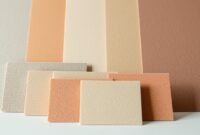Ever wondered when to take off concrete forms? Getting it wrong can mess up your project. If you remove them too soon or too late, you risk weak structures and costly fixes.
It’s not just about waiting. You need to know the exact right time. Things like the type of cement, weather, and project details all matter.
In this guide, I’ll show you how to get concrete curing just right. You’ll learn to avoid mistakes and get top-notch results every time.

Understanding the Basics of Concrete Forms
Concrete forms are key in construction, shaping and supporting concrete as it cures. As a construction pro, I know how important it is to get formwork right. It’s all about successful project completion.
Read also: Board Formed Concrete for Walls
Concrete forms are like temporary molds that shape structures. They’re vital for precise shapes and strong structures. Each project needs its own formwork plan for safe removal and strong concrete.
What Are Concrete Forms?
Concrete forms do a lot in construction:
- They shape and size concrete structures
- Support concrete until it’s strong enough
- Make sure concrete surfaces are smooth
- Keep concrete safe while it cures
Purpose of Formwork in Construction
Formwork does more than just mold concrete. It’s key for concrete strength. During the strength test, forms keep the shape and protect the concrete.
Types of Concrete Forms
There are many form types for construction:
- Wooden forms: Cost-effective and traditional
- Metal forms: Durable and can be reused
- Plastic forms: Light and easy to move
- Fabric forms: Flexible for complex shapes
Choosing the right form depends on the project, budget, and finish. Knowing these basics is key to good concrete construction.
The Concrete Curing Process Explained

Knowing how to cure concrete is key to making strong structures. The process starts right after pouring. It involves important steps that affect the concrete’s strength and quality.
Concrete curing is a chemical change. It turns cement, water, and aggregates into a solid. In the first 24-48 hours, it sets quickly. But it takes up to 28 days to reach full strength.
- Initial curing phase: 24-48 hours of critical setting
- Intermediate curing: Developing structural integrity
- Final curing: Reaching maximum compressive strength
There are different ways to cure concrete. This affects how well it performs. Two main methods are:
| Curing Method | Key Characteristics |
|---|---|
| Water Curing | Keeping concrete constantly moist for optimal hydration |
| Chemical Membrane Curing | Applying compounds that slow moisture evaporation |
Temperature, humidity, and the mix design are very important. Contractors try to keep moisture and temperature steady. This helps the concrete develop evenly and avoid cracks.
By following the right tips and understanding the curing process, builders can make their concrete last longer and perform better.
When to Remove Concrete Forms?
Removing concrete forms is a key step in building that needs careful planning and skill. Knowing when to remove forms is vital for keeping structures strong and avoiding cracks. Contractors must consider several important factors before removing forms.
Minimum Strength Requirements
Concrete strength is the main factor in deciding when forms can be removed safely. My experience shows forms should be removed when the concrete can handle twice the stress it will face later. This depends on many things:
- Concrete mix design
- Ambient temperature
- Curing conditions
- Structural load requirements
Testing Methods for Concrete Strength
Testing concrete strength is done through several reliable methods. The most common ones are:
- Cylinder compression tests
- Non-destructive testing techniques
- Rebound hammer tests
Safety Considerations During Removal
Removing forms safely needs careful attention. Workers must use the right tools and follow strict safety rules to avoid damage or injury.
| Cement Type | Recommended Curing Time |
|---|---|
| Type I Cement | 7 days |
| Type II Cement | 10 days |
| Type III Cement | 3 days |
| Type IV/V Cement | 14 days |
By sticking to these guidelines, contractors can avoid cracks and ensure structures work well. Remember, removing forms too early can weaken concrete, while waiting too long doesn’t harm it more.
Standard Timeline for Form Removal
When working with concrete, knowing when to remove forms is key. It ensures the structure is strong and safe. The time it takes for concrete to set and dry is important.
I’ve made a detailed checklist for removing forms. It helps both pros and DIY folks. The usual time is 24 to 48 hours after pouring. But, several things can change this.
- Walls and columns: 24-48 hours after pouring
- Slabs: 3-4 days of curing
- Soffits: Approximately 1 week
- Vertical surfaces: Can often be removed faster than horizontal surfaces
Concrete gets stronger based on several factors:
- Ambient temperature
- Concrete mix design
- Cement type
- Structure size and complexity
Different cements need different times to remove forms:
| Cement Type | Recommended Removal Time |
|---|---|
| Type I | 7 days |
| Type II | 10 days |
| Type III | 3 days |
| Type IV or V | 14 days |
Always test the concrete strength before removing forms. It should hold twice the stress it will face later. In warm weather, concrete gets stronger faster. Cold weather slows it down.
Being patient with the curing process is important. It helps avoid problems and makes the concrete last longer.
Factors Affecting Concrete Form Removal Time
Knowing when to remove structural support forms is key for strong concrete. Several important factors decide when it’s safe to take them off.

Temperature and Weather Conditions
How fast concrete dries changes a lot with the weather. The temperature is a big factor in how strong it gets. When it’s warm, concrete dries faster. But in cold weather, it takes longer.
- Warm temperatures: Faster strength gain
- Cold temperatures: Slower curing process
- Humidity impacts moisture evaporation and strength development
Concrete Mix Design
The mix of your concrete affects when you can remove the forms. Different cements and concrete types cure at different speeds. High-grade concrete with special cements can cure faster, letting you remove forms sooner.
- Cement type influences curing speed
- Higher concrete grades develop strength quicker
- Specialized additives can accelerate curing
Read also: Board Formed Concrete for Walls
Structure Size and Type
The size and type of your concrete structure also matter. Bigger structures need more time to be strong enough. Walls, columns, and beams have their own rules for removing forms.
- Small structures: Faster form removal
- Large structural elements: Longer curing time
- Complex shapes may need extended form support
By thinking about these factors, you can figure out the best time to remove concrete forms. This ensures your structure is strong and lasts long.
Water Curing Methods and Their Impact
Water curing is key for strong and durable concrete. It keeps the surface moist, stopping it from drying too soon. This helps the hydration process. Knowing how to water cure can greatly improve your concrete’s performance.
The water curing process uses several techniques to keep the concrete moist. It starts about an hour after the concrete is poured. This is when the surface water has mostly evaporated.
- Ponding: Submerging flat concrete surfaces in water
- Spraying: Continuously misting concrete surfaces
- Wet coverings: Using saturated burlap or similar materials
- Plastic sheet coverage: Preventing moisture evaporation
Research shows hydration is 30% done in 3 days and 60% in 7. The American Concrete Institute says concrete needs at least 7 days to reach 70% strength.
| Curing Method | Effectiveness | Best Used For |
|---|---|---|
| Ponding | High | Flat horizontal surfaces |
| Spraying | Medium | High temperature environments |
| Wet Coverings | High | Vertical and horizontal surfaces |
When water curing, aim for a temperature of 68°F. Keeping the concrete moist makes it stronger but takes more work. Make sure your fabric or covering is soaked and clean to avoid stains.
By using the right water curing methods and following the recommended time, you’ll make concrete that lasts longer and is more durable.
Using Curing Compounds for Better Results
Concrete hardening tips are key for lasting and strong projects. Curing compounds protect and improve concrete early on. They are vital during the setting and hardening stages.
Types of Curing Compounds
There are several important types of curing compounds used by contractors:
- Water-based compounds with low V.O.C.’s
- White pigmented compounds for exterior surfaces
- Clear membrane-forming solutions
- Silicone-based penetrating compounds
Application Techniques
Applying curing compounds needs to be done right. The American Concrete Institute has guidelines for the best results:
- Apply after surface water evaporation
- Use paint rollers or sprayers for even coverage
- Maintain application rate of 200-300 square feet per gallon
- Ensure minimum 15% solids content
| Compound Type | Application Rate | Recommended Use |
|---|---|---|
| Water-based | 250 sq ft/gallon | Interior surfaces |
| White Pigmented | 200 sq ft/gallon | Exterior structures |
| Clear Membrane | 300 sq ft/gallon | Pavement and decks |
Removal Process
Removing curing compounds needs careful thought. Shot blasting is best for preparing surfaces for more treatments or tile. The ceramic tile industry stresses the need for full removal for strong bonding.
The hydration process goes on for weeks. About 30% is done in 3 days and 98% in 28 days. Pick your curing compound wisely to help this important process.
Common Mistakes to Avoid During Form Removal
Removing concrete forms needs careful attention to avoid damage. I’ve seen many projects ruined by hasty or wrong form removal. Knowing the right construction safety tips can save you from costly repairs and structural failures.
There are several mistakes that can harm your project’s integrity:
- Removing forms too early, which weakens structural strength
- Ignoring temperature and weather conditions during removal
- Failing to conduct proper strength testing before form removal
- Uneven or hasty form removal causing unnecessary stress
Temperature is key in concrete curing. Cold weather slows down hardening, making early form removal risky. Always use temperature-specific guidelines to avoid cracks and ensure strength.
Safety is always first. Here are key precautions to follow:
- Conduct thorough strength tests before removing forms
- Use proper protective gear during removal
- Ensure gradual and controlled form removal
- Check for any signs of possible structural weakness
By following these steps, you’ll reduce risks and ensure a successful concrete project. It will meet professional standards and safety needs.
Conclusion
Exploring concrete forms has shown me how important removal techniques are. It’s not just about timing. It’s about keeping the structure strong and lasting long.
Removing forms too soon can cause big problems. The American Concrete Institute says to wait until the concrete is 50% to 75% strong. This means being patient is key to avoiding damage.
Most forms can be taken off in 24 to 48 hours. But, things like temperature and the concrete mix can change this. Builders need to be ready for different situations. By following the right steps, you can make structures that last.
Success in concrete work comes from being precise and knowledgeable. Whether it’s foundations, walls, or big structures, knowing how to remove forms is essential. It’s the way to achieve excellence in building.


